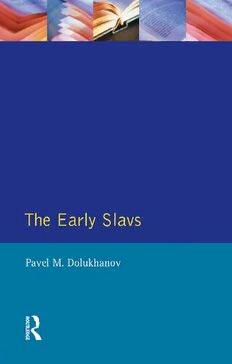
The Early Slavs: Eastern Europe from the Initial Settlement to the Kievan Rus PDF
Preview The Early Slavs: Eastern Europe from the Initial Settlement to the Kievan Rus
The Early Slavs This page intentionally left blank The Early Slavs Eastern Europe from the Initial Settlement to the Kievan Rus Pavel M. Dolukhanov ~ ~~o~~~~n~~~up LONDON AND NEWYORK Firstpublished1996byAddisonWesleyLongmanLimited Published2013byRoutledge 2ParkSquare,MiltonPark,Abingdon, Oxon OX144RN 711ThirdAvenue,NewYork,NY10017,USA RoutledgeisanimprintoftheTaylor&FrancisGroup,aninformabusiness Copyright©1996,Taylor&Francis. Allrightsreserved. Nopartofthisbookmaybereprintedorreproducedorutilised inanyform orbyanyelectronic,mechanical,orothermeans, nowknownor hereafterinvented, includingphotocopyingandrecording,orinanyinformation storageorretrievalsystem,withoutpermissioninwritingfromthepublishers. Notices Knowledge andbestpracticeinthisfieldareconstantlychanging.Asnewresearch andexperiencebroadenour understanding,changes inresearchmethods, professionalpractices,ormedicaltreatmentmaybecomenecessary. Practitionersandresearchersmustalwaysrelyontheirownexperienceand knowledgeinevaluatingandusing anyinformation,methods,compounds,or experimentsdescribedherein.Inusingsuchinformationormethodstheyshould bemindfuloftheirownsafetyandthesafetyofothers,includingpartiesforwhom theyhaveaprofessionalresponsibility. Tothefullestextentofthelaw,neitherthePublishernortheauthors,contributors,or editors,assumeanyliabilityforanyinjuryand/ordamagetopersons orpropertyasa matter ofproductsliability,negligenceorotherwise,orfromanyuseoroperationof anymethods,products,instructions,orideascontainedinthematerialherein. ISBN13:978-0-582-23618-9(pbk) BritishLibraryCataloguing-in-PublicationData Acataloguerecordfor this bookisavailablefrom the British Library LibraryofCongressCataloging-in-PublicationData Dolukhanov,PavelMarkovich. The early Slavs:EasternEurope from the initial settlementto the Kievan Rus /PavelM. Dolukhanov. p.cm. Includes bibliographicalreferences andindex. ISBN0-582-23627-4 (casebound).- ISBN0-582-23618-5 (pbk.) 1.Slavs- History.2. Europe, Eastern- History. 1.Title. D]K27.D651996 95-45474 CIP Contents ListofIllustrations VlI Preface IX Transliteration ofCyrilic Names XlI 1. The Slavs and Archaeology in Russia 1 2. Geographical Setting 8 Geologyand landforms 8 Hydrology 13 Climate 14 Vegetation and soils 14 Populationandethnicgroups 18 3. The Initial Settlement 23 Palaeolithicbeginnings 23 The Last IceAge 29 The Mousterian 30 The UpperPalaeolithic 34 The Late Glacial 41 Early languages 44 4. Postglacial Farmers and Hunters 47 The Holocene 47 The Mesolithic 51 Early Neolithic 62 MiddleNeolithic 76 v The EarlySlavs 5. The Beaker Folks 81 The Post-optimum 81 The CordedWare 82 The steppegroups 91 The Bronze Age 96 6. The Age of Change 109 The Iron Age 109 The northernhill-forts 113 The Cimmerians, Scythians, Greeks and ... 117 7. The Slavs, BaIts and Finns 137 8. The Slavsin Europe 146 Pax Romana 146 The Zarubintsy and Chernyakhovian 148 The rise of the Slavs 160 The Slavsin the north 167 9. The Vikings and the Rus 171 The Little Optimum 171 The Vikings in Europe 173 The Scandinavians andthe Slavs 177 The beginnings of Russian statehood 193 Conclusions 198 Glossary 201 Bibliography 210 Index 231 VI List of Illustrations Fig. 1. Tectoniczones 9 Fig. 2. Surface configurations 11 Fig. 3. Climate. MeanJanuarytemperature (CO) 15 Fig. 4. Vegetation 16 Fig. 5. Soils 19 Fig. 6. Languages and linguisticgroups 21 Fig. 7. The initialsettlement. Lower andMiddlePalaeolithicsites 27 Fig. 8. The UpperPalaeolithic 36 Fig. 9. UpperPalaeolithic 'dwelling'. Kostenki 11, stratum 1a 37 Fig. 10. Palaeolithic 'portable' artfrom Kostenki sites 40 Fig. 11. Late Glacialmigrations 44 Fig. 12. Climaticoscillations of the Holocene 48 Fig. 13. Figurines from Oleneostrovskicemeteries (Karelia andKola peninsula) 54 Fig. 14. Voloshskicemetery 56 Fig. 15. Mesolithictools. (a)- SouthernUkraine; (b)- Estonia (Kunda) 59 Fig. 16. Mesolithicculturalgroupings in Eastern and CentralEurope 61 Fig. 17. Bug-Dniestian (a)andDniepr-Donetsian (b)ceramics 63 Fig. 18. Tripolian antlerandstone implements,ceramics and figurines 67 Fig. 19. Kolomiishchinasettlement(reconstruction) 68 Fig. 20. Eastern Europe in the Early Neolithic 74 Fig. 21. Pit-and-combpottery 76 Fig. 22. Eastern Europe in the Middle Neolithic 77 Fig. 23. Neolithic petroglyphs inKarelia 79 Fig. 24. EasternEurope inthe late Neolithic/earlyBronze Age 83 Fig. 25. FatyanovoWare 86 Fig. 26. Volosovo flint figurine 88 Fig. 27. Pit Graves (a), Catacomb Grave (b)and Timber Grave (c) 93 Fig. 28. Bronze Agefortified settlementat Kivukalns, Latvia 98 Fig. 29. Sosnitsianinventory 100 Vll The EarlySlavs Fig. 30. Seima-Turbinosites 104 Fig. 31. Seima-Turbinospearheads (upperrow) andaxes 105 Fig. 32. Cross-sectionof the Scythian 'royal' barrow. Tovstaya Mogila,Ukraine 122 Fig. 33. Scythian 'animal' style 126 Fig. 34. Forest-steppe 'Scythian'groups 128 Fig. 35. Greekcolonies in the north Pontic area 130 Fig. 36. Eastern and Central Europe in the first millenniumBe 134 Fig. 37. Zarubintsy (1)and Chernyakhovian (2) 149 Fig. 38. Gothicwars 156 Fig. 39. The East European Plain in the first millenniumAD 161 Fig.40. Pottery, settlementand dwellings of Prague-Korchaktype 162 Fig.41. Pottery, settlementand dwellings of Prague- Pen'kovkatype 164 Fig.42. Long barrows andsopkis in the Novgorod district 166 Fig.43. Birka in the tenthcenturyAD (reconstruction) 175 Fig.44. Trade routes in Eastern Europe in the 9th-10thcenturiesAD 178 Fig.45. Volkhov in the Staroja Ladoga area 183 Fig.46. Archaeologicalsites in the Novgorodarea 185 Fig.47. The Old Kiev 192 V111 Preface I am beginning this book with apologies, and.myfirst apology concerns the title. The Slavs, as a distinct ethnicity, were first mentioned by Greek writers only in the second century AD·whereas I begin my story with the initial appearance of tool-making hominids in Russian territory, which occurred c. 500 thousandyears before that. During the millennia which have left no written documents, the succeeding generations of people who lived in the vast spaces of the Russian Plain could hardly be described as belonging to any ethnic entity; they had no common name, whether it was 'Slavs' or anything else. The same is true for large groups of early humans in any other part of the world. Yet I am convinced that Iam right in choosingthis time dimension for my story. The origins and early development of peoples known as the Slavs could be rightly understood only ifviewed from awide temporal perspective. My second apology follows directly from the first. Having chosen to write a wide panorama of Slavic pre- and proto-history, I necessarily transgressed into areas lessfamiliar to me professionally. At this moment, it is inevitable that I must say a few words about myself. I was trained as a geomorphologist and Quaternarygeologist at the University of Leningrad (now St Petersburg) in Russia (formerly the USSR). Immediately after graduating in 1960, I joined the staff of the Leningrad Institute of Archaeology, Academy of Sciences of the USSR. Since then I have conducted palaeoenvironmental and geochronological investigations of archaeological sitesin more or lessall parts of the former USSR. These studies were mainly concerned with Mesolithic and Neolithic Age sites and pivoted around the problem of the Mesolithic-Neolithic transition. I was especially interested in the study of the emergence of agriculture and stock-breeding in their environmental context, and in the various social, cultural and linguistic implications of this. Yet, being one of the few environmental scientists directly involved in archaeology, Iwas obliged from time to time to work on IX
